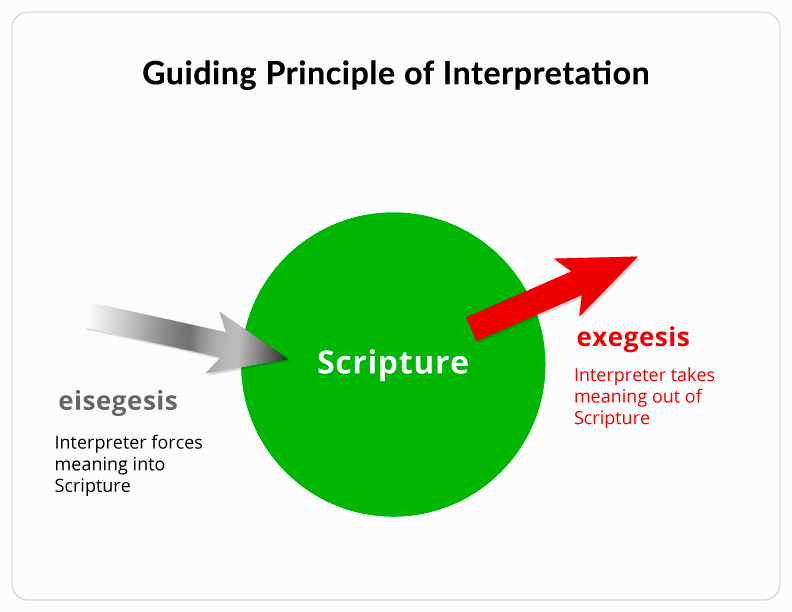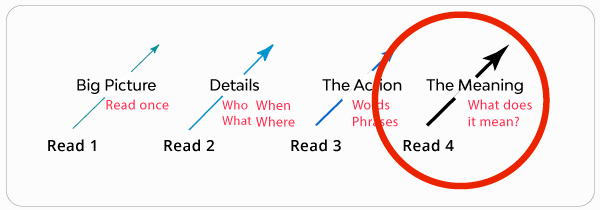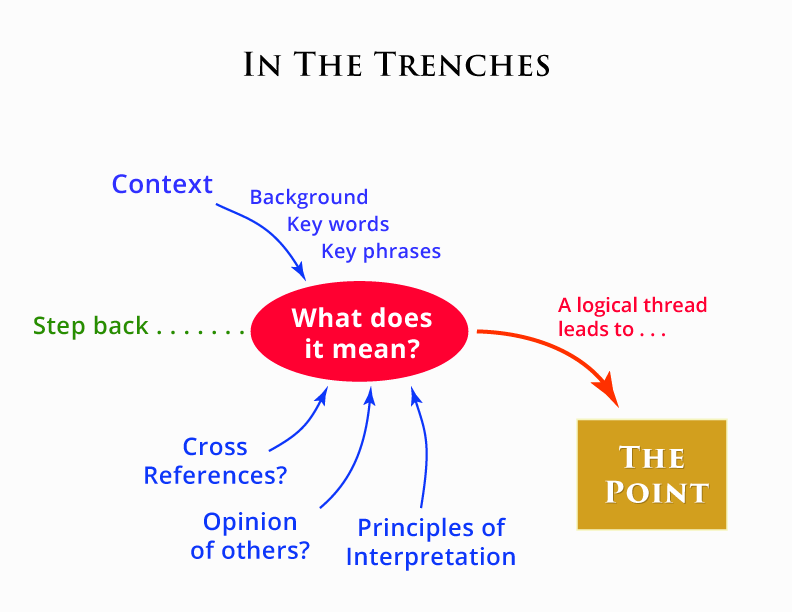
In our last study, we explored tools that will help us discover the meaning of Scripture. Now we want to ask, “What does it mean?” and move through the trenches of discovering the meaning of Scripture.
In this study we will apply the chart “In The Trenches” to help us know the meaning of Scripture before we can know the application. We are going to discover that once we know the meaning of a verse or passage, the application should become obvious or almost obvious. The application is called “The Point” of the verse or the passage.

The Canaanite Woman — Matthew 15:21-28
The passage that we have been studying is Matthew 15:21-28. So, let’s begin by re-reading Matthew 15:21-28. The passage says,
Jesus went away from there, and withdrew into the district of Tyre and Sidon. And a Canaanite woman from that region came out and began to cry out, saying, “Have mercy on me, Lord, Son of David; my daughter is cruelly demon-possessed.” But He did not answer her a word.
And His disciples came and implored Him, saying, “Send her away, because she keeps shouting at us.” But He answered and said, “I was sent only to the lost sheep of the house of Israel.”
But she came and began to bow down before Him, saying, “Lord, help me!” And He answered and said, “It is not good to take the children’s bread and throw it to the dogs.” But she said, “Yes, Lord; but even the dogs feed on the crumbs which fall from their masters’ table.” Then Jesus said to her, “O woman, your faith is great; it shall be done for you as you wish.” And her daughter was healed at once. Matthew 15:21-28 (NASB)
Discovering the Meaning
At this point, we have collected some very important information. We have asked questions such as:
Who is mentioned in the passage? What happened? When? Where? Who said what?
We have many pieces now to our puzzle. Now we must put the puzzle together piece-by-piece to discover the meaning of the verse or passage. But in order to accomplish this, our first step must be to accurately interpret Scripture. 2 Timothy 2:15 teaches us to accurately handle the word of truth. It says,
Be diligent to present yourself approved to God as a workman who does not need to be ashamed, accurately handling the word of truth. 2 Timothy 2:15 (NASB)
The Greek word that is translated as “accurately handling” is orthotomeo. It literally means “straight cut.” That is, any deviation from the truth is a twisted cut.

The process of performing a “straight cut” is called exegesis. Exegesis refers to taking meaning out of Scripture and not forcing our viewpoint into the passage. Discipline is required in order to accomplish this. If we force our opinion, our viewpoint, or our interpretation into Scripture, we perform what is called eisegesis. Then we have dishonored God by distorting what He wrote. It is like changing someone’s email or text and then forwarding it to other people. We might like the change, but God will not.
Our second step is to pray and ask the Holy Spirit to help us come to the correct meaning. We also need to take time to meditate on what the passage says—all the pieces of the puzzle, preferably for a day or at least for an evening. We may need to repeat some of the previous steps in “What does it say?”
Next, we need to use our Bible tools, especially the cross-references and commentaries. We need to evaluate our interpretation against the interpretations of other trusted authors. It is helpful to check with authors before the 1900s, if we can, since they lived during a different culture. We should be aware that our culture can greatly influence our understanding of a passage of Scripture. We tend to interpret Scripture through the eyes of our culture. These tools should cause us to reevaluate our viewpoint and help us to not miss important details. Eventually, we will reach a conclusion about the interpretation.

Principles of Interpretation
Now we need to discuss some principles that will guideline us. So, I want to discuss eleven principles of biblical interpretation that should be applied to every passage. As you use them, you will eventually memorize them. Before we discuss the principles, it is important to say that all of these principles do not always apply to every passage we are studying. Also, these principles do not need to be applied in this order.

1) Understand Scripture literally, unless it is clear that it is figurative
The first principle is that we must understand Scripture literally, unless it is clear that our passage is figurative. In our study, Matthew 15:21-28, it is clear that the “lost sheep of the house of Israel” (v. 24), “the children” (v. 26), “dogs” (v. 26-27), and “crumbs” (v. 27), may be figurative terms. Now someone may quickly conclude they are figurative after reading them. But after reading a few commentaries, it becomes obvious some authors think they are literal terms. So, this introduces another issue. We must determine if they are figurative or literal. If we assume that the children, the dogs, and the crumbs are literal, we have a problem. That is, it becomes very difficult to explain why Jesus said this in verse 26,
It is not good to take the children’s bread and throw it to the dogs. Matthew 15:26 (NASB)
Was Jesus just teaching her that it is not good for dogs to eat the children’s bread? If so, then it is difficult to understand why she spoke of crumbs in verse 27. If it is not good to eat bread, then it is also not good to eat the crumbs from the bread. Also, why would Jesus say in verse 28 that the Canaanite woman’s “faith is great?” So, we need to determine if children, bread, dogs, and crumbs have historical or cultural meanings.
2) Culture, history, language, and geography may affect the meaning
The second principle requires us to discover meaning that is revealed by the culture, history, language, and geography. We have already discovered some of these facts when we asked the question, “What does it say?” We have already learned that the term “dogs” was a term Jews used for Gentiles. It was a derogatory term. That helps us understand that most likely verses 26-27 are figurative. If so, what is the cultural meaning of “children”?
We have already discovered that the “crumbs” from bread were like soiled table napkins. The crumbs resulted from people cleaning their hands at a meal by wiping their hands on bread, causing dirty crumbs to fall to the ground.
The term Canaanite referred to someone who worshiped false gods and goddesses. Baal and Asherah were worshiped. They practiced religious prostitution (1 Kings 14:23-24), and human sacrifice (Jeremiah 19:5). This reveals that this Canaanite woman was raised in a godless culture. So, why did she seek Jesus and not someone else? Cultural information reveals the term “Son of David” was a messianic title. Therefore, we have another important question, why does she call Jesus, Lord, three times in this passage and call Him by this messianic title? This seems to indicate that she may have already believed Jesus was the Christ, the anticipated Messiah. Why else would she have come to Him?
It is also significant that a “woman” visited Jesus and spoke with Him. Jewish men did not talk publicly with women, especially Gentile women. This suggests that she was desperate and believed in Christ.
3) The context may affect your understanding of the passage
The third principle states that the context may affect our understanding of the passage we are studying. So, if we read Matthew 15:15-20 and Mark 7:17-23, we discover that Jesus had just explained that what proceeds out of the mouth comes from the heart. This helps us understand why the Holy Spirit placed the story about the Canaanite (Syrophoenician) woman next. The Holy Spirit wants us to pay attention to the words of this Canaanite woman. Her words reveal her heart.
4) Avoid proof texting (a series of verses that do not actually prove your point)
The fourth principle warns us against using Scripture verses that do not mean what we say they mean. That is, we misunderstood them and use or apply them incorrectly. For example, someone has claimed that Psalm 119:176 explains the meaning of the term the “lost sheep of the house of Israel.” But a careful study of the passage reveals that it is not about Israel, but about an individual person who says he had wandered off like a lost sheep. Further, the term “lost sheep of the house of Israel” is not even mentioned in the verse.
5) Let Scripture interpret Scripture
All Scripture fits together. The fifth principle states that we can use other Scriptures to help us understand the Scripture we are studying. Why? Because the Holy Spirit wrote every word of Scripture. Remember Scripture has two authors – a human author and the Holy Spirit (2 Peter 1:20-21). We discovered that in our second study, “Why We Can Trust The Bible.”
We must remember this principle when we use other Scripture to help us understand a passage. For example, John 4:9, 27 help us understand the significance of the woman speaking to Jesus. Here are the verses,
Therefore the Samaritan woman said to Him, “How is it that You, being a Jew, ask me for a drink since I am a Samaritan woman?” (For Jews have no dealings with Samaritans.) John 4:9 (NASB)
At this point His disciples came, and they were amazed that He had been speaking with a woman, yet no one said, “What do You seek?” or, “Why do You speak with her?” John 4:27 (NASB)
These two verses reveal that the Jews normally did not speak with non-Jews. They did not talk with Samaritans or Gentiles. Further, John 4:27 reveals that, Jewish men did not usually speak publicly with women. This reveals that Jesus’ discussion with the Canaanite woman was very special. It reveals His heart toward this woman. This may also be another reason why the disciples wanted Jesus to send her away.
6) Scripture does not contradict Scripture
The sixth principle reminds us that Scripture cannot contradict Scripture. Why? Because once again, the Holy Spirit wrote the Bible. Since the Holy Spirit is the author, there cannot be any contradictions. An example of a supposed contradiction is Mark 1:32 and Luke 4:40.
When evening came, after the sun had set, they began bringing to Him all who were ill and those who were demon-possessed. Mark 1:32 (NASB)
While the sun was setting, all those who had any who were sick with various diseases brought them to Him; and laying His hands on each one of them, He was healing them. Luke 4:40 (NASB)
Both passages are about the same event. Mark says the sun had set, but Luke says the sun was setting. This appears to be a contradiction. But the Talmud Shabbat 34b-35a and Talmud in Pesachim 94a reveal the Jews had different definitions of sunset. Mark used the definition that sunset occurred because the sun had dropped below the horizon. While Luke used the definition that the sun had dropped below the horizon, but was not yet totally dark. Therefore, this principle will guide our selection of cross-references.
7) Obscure passages must give way to clear ones
The seventh principle warns us against using obscure passages to establish doctrine. One obvious example is 1 Corinthians 15:29. The verse reads,
Otherwise, what will those do who are baptized for the dead? If the dead are not raised at all, why then are they baptized for them? 1 Corinthians 15:29 (NASB)
It discusses baptizing the dead. Now, we do not know what that means, and there are no other Scriptures that can help us understand 1 Corinthians 15:29. This means that this is an obscure verse. We must not establish any doctrine on such a passage.
8) No truth should be gleaned from uncertain textual readings
The eighth principle we have already visited in the study titled, “Preparing To Know What The Bible Says.” There are no uncertain textual readings in the passage we are currently studying.
9) If Scripture has not spoken, we are wisest to be silent
Principle number nine says that if the Scripture does not tell us some facts, then we must avoid making dogmatic statements. We should be very careful unless it is very obvious that most likely our statement is true. If we do claim something is true when Scripture is silent, then we should clearly say that we are speculating. In this passage, someone has said that unbelievers usually have greater faith than believers. But that cannot be proven from this passage.
Another example of this principle is that Christians have often claimed that Matthew 28:19-20 proves the Trinity. But some cults claim that it proves there are three gods because the passage never says they are one.
10) Scripture is the only certain source of truth, and not our experience or science
This tenth principle is often missed. That is, science and our experience does not determine truth. In fact, science routinely changes its theories as demonstrated by James Burke in his article titled, “As a Matter of Fact.” It was published by Forbes 10.02.00. Also, our experience does not determine truth. When Scripture has spoken about a subject, it is the final authority since God is speaking.
11) Be teachable . . . be willing to reconsider what you believe!
The eleventh principle is a reminder — we must be teachable if we want to know the truth and glorify our God. 1 Corinthians 10:31 states that we are to glorify God in all that we do. If you are a teacher, James 3:1 warns you about incurring a stricter judgment because your audience has the potential of stumbling as you teach.
These are eleven essential principles for determining the meaning of Scripture. We will learn about principles for application in our next study.
Summary of the Meaning
Now we will summarize the meaning that we have discovered from Matthew 15:21-28 and Mark 7:24-30.
Woman Meets Christ
We are told in Mark 7:24 that Jesus wanted to escape the crowds. We could say He wanted a sabbatical or a mini-vacation. So, He went to the region of Tyre and Sidon to escape the Jews. He entered a house. Yet, people found Him. He could not escape being noticed.
Matthew 15:21 tells us that a Canaanite woman, who was also a Syrophoenician by race, came from the region of Tyre and Sidon. Mark 7:25 says that she heard about Him, somehow found Him, and fell prostrate at Jesus’ feet. Now that must have been amazing to see a Gentile woman fall at the feet of a Jewish man. I wonder what the disciples were thinking?
The Greek word, karzo, in Matthew 15:22 is in the imperfect tense. That means she was repeatedly shouting, “Have mercy on me, Lord, Son of David; my daughter is cruelly demon-possessed.” The gospel of Mark also tells us that she was repeatedly shouting. Imagine being Jesus. You have gone to Gentile territory for peace and rest, but you cannot find it. Then a Gentile woman finds you. Immediately, you know she has a desperate need because she falls at your feet and begins loudly shouting, “Have mercy on me, Lord, Son of David; my daughter is cruelly demon-possessed.” How would you feel? How do you think the disciples felt since they knew Jesus had wanted some rest? How would you feel if you were the woman with a demon-possessed daughter?
The context of this account tells us that Jesus had just taught the disciples that what comes out of our mouth reveals our heart. So, when Matthew says that she referred to Jesus by the messianic title “Son of David” (Matthew 1:1, 20), this suggests she believed He was the Messiah. In addition, her actions and words reveal the woman clearly believed Jesus could heal her daughter. They revealed her heart.
Jesus and the Disciples
Matthew 15:23 amazes us when we are told that Jesus did not answer her a word. We would not expect that from Jesus. If you were Jesus, why would you do this? Why did Jesus do that? We know that He did not ignore her because she was a Gentile woman. He did not ignore her because He hated her or did not care about her. John 3:16 and 1 John 4:16 remind us that Jesus, as the God man, loved everyone, including this woman. John 3:16 says that, “God so loved the world,” and 1 John 4:16 states that “God is love.” This means that Jesus cared about and loved the woman. So, why did He ignore someone He loved?
In sharp contrast, the disciples did not love her. The Greek tense of the word “implored” is also in the imperfect tense in Matthew 15:23. It reveals the disciples were repeatedly begging Jesus to send her away. They explained that “she keeps shouting at us.” This was a very dynamic situation. They were irritated with her. Did they hate Gentiles? We do not know the answer, just like we do not know if they wanted Jesus to heal her and then just send her away. But it is clear that Jesus did not send her away. So, why did Jesus ignore her and yet, not send her away? We can be confident the disciples did not understand. Maybe we do not understand either.
When Jesus said, “I was sent only to the lost sheep of the house of Israel,” it is possible that Jesus, when He did not send her away, simply wanted to assure the disciples that His priority still was for the nation of Israel (Matthew 10:5; John 4:22). I think Jesus wanted her to hear this statement. Now I cannot prove that, but that is my opinion.
Jesus and the Woman
Matthew 15:25 says that she was repeatedly bowing down before Jesus. Why did she repeatedly bow down? Once again, her actions reveal her heart. She believed this man, Jesus, could heal her daughter. She believed in Jesus. Whatever her reason, the situation was very dynamic. She was bowing and shouting. The disciples wanted Jesus to send her away. Jesus refused to send her away. Jesus assured the disciples that His priority was the nation of Israel.
Then everything came to a climax when He said to her, “It is not good to take the children’s bread and throw it to the dogs.” Since the Jews called Gentiles dogs, Jesus told her that she was an outsider. It was not good to throw the “bread” that belonged to the Jews to the Canaanites. In the Greek language, there are two different words for dog. Jesus used the Greek word, kunarion. It refers to a pet dog. Gentiles had pet dogs. Jesus did not use the Greek word, kuon, which referred to wild dogs. When Jesus said, “to show her kindness,” He inferred that she was like a pet dog. He showed her kindness. He revealed His heart for her. He revealed His love for her.
Then she responded with, “Yes, Lord; but even the dogs feed on the crumbs which fall from their master’s table.” “Crumbs” that fell from the table were the result of people cleaning by wiping their hands with a piece of bread. The crumbs were like a soiled napkin. When she said this, she used the same word for dogs that Jesus did. She told Jesus that she was willing to take whatever Jesus gave her, even dirty crumbs. She completely humbled herself before Christ. She had come bowing prostrate on the ground, shouting repeatedly, begging, and now she says, “I am a dog!” I am willing to accept even filthy crumbs. This Gentile woman had completely humbled herself before the Jewish Messiah. She believed in Him. Please give me a crumb! She believed that Jesus could heal. Whatever He did would be enough to heal her daughter. She believed in Jesus. So, she humbled herself before Jesus and the watching disciples.
Jesus Praises The Woman
Then in Matthew 15:28, Jesus said to her, “O woman, your faith is great; it shall be done for you as you wish.” That is the climax. We are also told the daughter was healed at once in Mark 7:29-30.
Conclusion
But why did He say her faith was great? What are some applications? The answers to these questions and “How to Apply the Meaning” are in our next study.
Suggested Links:
How To Study the BibleWhy Study the Bible? — benefits of studying the Bible
Why We Can Trust The Bible — inspiration and the canon of Scripture
Preparing to Study the Bible, part 1 — why so many interpretations?
Preparing to Study the Bible, part 2 — avoiding errors in interpretation
Preparing To Know What The Bible Says — best Bibles and more
What Does The Bible Say? — example of observing
Tools For Determining The Meaning — books and software for Bible study
How to Apply the Meaning — principles to discover the application